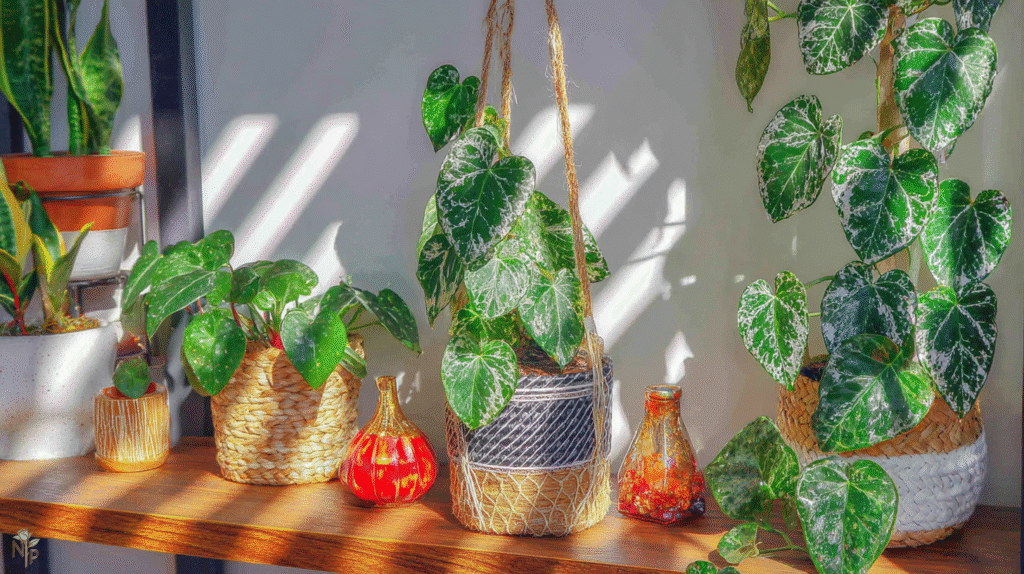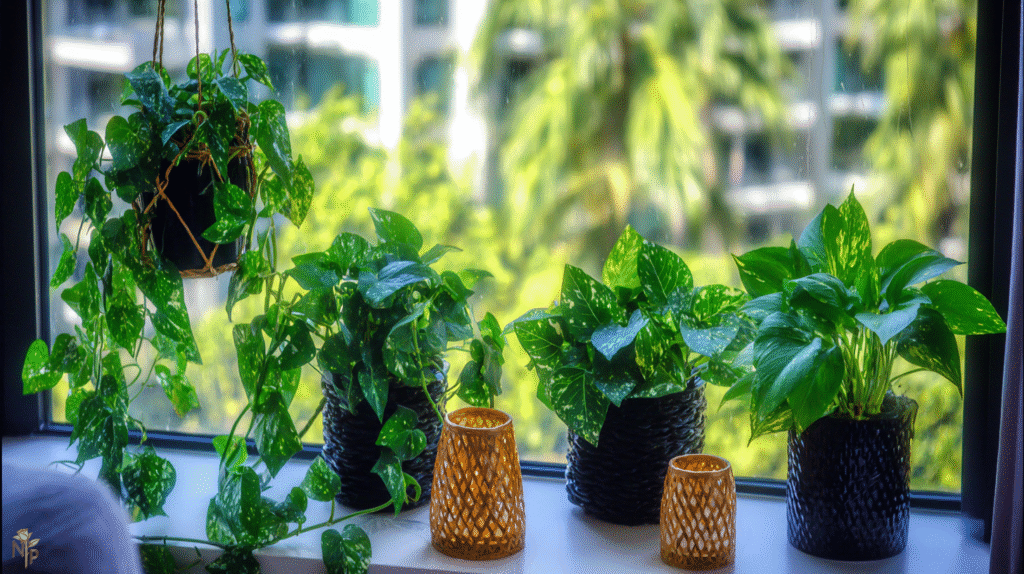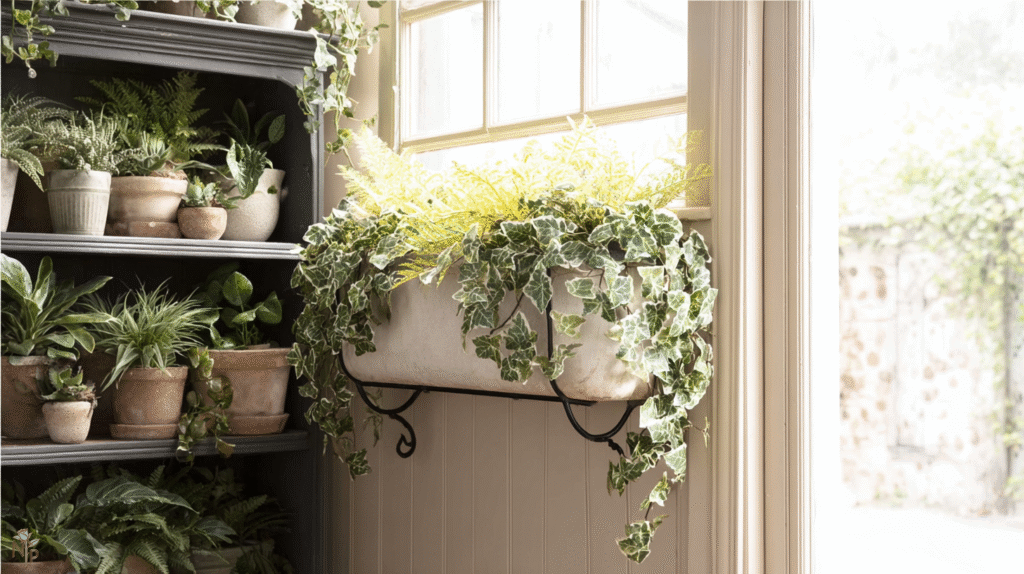My ivy obsession started innocently. One English ivy at Target. “Great for beginners!” the tag promised. Six months later, that ivy was dead, I was defeated, and somehow I’d convinced myself the problem was the variety, not my care. So I bought another type. Then another.
Three years and roughly twelve ivy varieties later (RIP to at least half), I finally get it. Not all ivies are created equal, and definitely not all ivies work in every home. That “perfect for beginners” English ivy? Turns out it wanted conditions my apartment couldn’t provide. Meanwhile, the Swedish ivy I bought on clearance — not even a real ivy — is thriving like it pays rent.
Here’s everything I learned about matching ivy species to your actual living conditions, not the fantasy greenhouse we all wish we had.

The Big Lie About Indoor Ivy
Let’s start with the truth bomb: most ivy species don’t actually want to live indoors. They tolerate it. There’s a difference. Outdoor ivy covers buildings and survives everything. Indoor ivy throws tantrums if you move its pot two inches.
The problem? We see ivy growing wild outside and assume it’s indestructible. Then we bring it into our 72-degree, low-humidity boxes we call homes and wonder why it’s crispy. It’s like expecting a wolf to act like a labradoodle.
But here’s the good news — once you match the right ivy to your specific conditions, they can be stunning indoor plants. You just need to be honest about what your home actually offers versus what you wish it offered.
English Ivy: The Demanding Classic
Scientific name: Hedera helix
What it wants:
Cool temperatures (50-70°F), high humidity, bright indirect light, and your constant attention
Reality check:
This is the variety that breaks most people’s ivy dreams. Mine sure did.
I tried growing English ivy in my normal-temperature apartment with average humidity. It responded by getting spider mites, dropping leaves, and generally looking like disappointment in plant form. English ivy wants to live in a cool, humid conservatory in England, not my heated apartment in Ohio.
Best for:
- Naturally cool homes
- Bathrooms with windows
- People who love misting and fussing
- Anyone with a humidifier already running
Skip if:
- Your home stays above 70°F
- You have forced air heating
- Low humidity is your reality
- You want low-maintenance anything
Varieties that are slightly more forgiving:
- ‘Glacier’ — handles warmth better
- ‘Needlepoint’ — smaller leaves, less dramatic
- ‘Gold Child’ — the variegation is worth extra effort
Algerian Ivy: The Better Beginner Choice
Scientific name: Hedera canariensis
What it wants:
Similar to English ivy but more chill about it
Reality check:
This should be renamed “Starter Ivy”
My Algerian ivy lives in the same spot that murdered my English ivy. Same temperature, same humidity, same everything. The difference? Algerian ivy has bigger, thicker leaves that don’t crisp up at the first sign of dry air. It’s like English ivy’s laid-back cousin.
Best for:
- Normal house temperatures
- Lower humidity tolerance
- Beginners who want real ivy
- Larger spaces (it grows big)
Skip if:
- You want delicate, tiny leaves
- Small spaces (seriously, it gets huge)
- You’re looking for lots of varieties
Swedish Ivy: The Ivy That Isn’t
Scientific name: Plectranthus verticillatus
What it wants:
Normal houseplant conditions
Reality check:
Best fake ivy ever
Okay, Swedish ivy isn’t actually ivy. It’s not even related. But it trails like ivy, looks ivy-ish, and — here’s the kicker — actually wants to live indoors. My Swedish ivy is the plant I point to when people say they can’t grow anything. It’s practically unkillable.
Best for:
- Beginners who want ivy vibes
- Normal house conditions
- Hanging baskets
- People who forget to water sometimes
Skip if:
- You’re an ivy purist
- You want that classic ivy leaf shape
- Slow growth is your preference (this thing explodes)
Grape Ivy: The Underrated Champion
Scientific name: Cissus rhombifolia
What it wants:
Low to medium light, average everything else
Reality check:
The apartment dweller’s best friend
Everyone ignores grape ivy because it’s not as flashy as English ivy. Their loss. My grape ivy lives in a corner that gets maybe 3 hours of indirect light. It’s full, green, and trailing everywhere. No drama, no special needs, just steady growth.
Best for:
- Low light situations
- Dry air tolerance
- Beginners wanting actual success
- Offices with fluorescent lights
Skip if:
- You want variegated options
- Fast growth is important
- You need that classic ivy look

Pothos: The “Ivy” Everyone Should Start With
Scientific name: Epipremnum aureum
What it wants:
To take over your home with minimal help
Reality check:
Not ivy, don’t care, it’s perfect
I know, I know. Pothos isn’t ivy. But it trails like ivy, it’s green like ivy, and — most importantly — it won’t die like ivy. My first pothos is now 12 feet of trailing glory. It survived everything my English ivy couldn’t.
Best for:
- True beginners
- Any light conditions
- Forgetful waterers
- People who want immediate success
Skip if:
- You’re stuck on having “real” ivy
- You have nibbling pets (toxic)
- You don’t want vigorous growth
Matching Ivy to Your Reality
Before buying any ivy, be honest about:
Your temperature:
- Always cold? English ivy might work
- Normal heating? Go Algerian or Swedish
- Hot apartment? Pothos all the way
Your humidity:
- Bathroom with shower? English ivy paradise
- Normal dry house? Choose thick-leafed varieties
- Desert-like? Stick to ivy alternatives
Your light:
- South-facing windows? Any ivy will work
- North-facing only? Grape ivy or pothos
- No windows? Just… don’t. Get a snake plant.
Your commitment level:
- Love fussing? English ivy needs you
- Want easy beauty? Swedish ivy or pothos
- Chronic neglect? Pothos will forgive you
The Conditions That Kill Indoor Ivy
After murdering multiple ivies, here are the death traps:
Hot, dry air: Forced air heating killed three of my English ivies before I figured it out. Now I keep them away from vents.
Overwatering: Killed an Algerian ivy this way. They want consistently moist, not swimming.
Wrong light: Too dark = leggy and sad. Too bright = crispy and sad. That sweet spot matters.
Spider mites: These bastards LOVE ivy, especially in dry conditions. Check weekly or suffer.
My Current Ivy Collection (The Survivors)
After all my failures, here’s what actually thrives:
Bathroom: English ivy ‘Glacier’ — the humidity from showers keeps it happy
Living room: Large Algerian ivy — tolerates normal conditions
Kitchen: Swedish ivy in hanging basket — loves the bright, humid environment
Bedroom: Grape ivy — handles the lower light
Office: Pothos — because I needed at least one guaranteed success
The Bottom Line on Choosing Indoor Ivy
Stop buying ivy based on how it looks in your Pinterest dreams. Buy based on what your home actually offers. That English ivy might be classic and gorgeous, but if you live in a dry, heated apartment, you’re setting yourself up for disappointment.
Start with the most forgiving varieties. Swedish ivy and pothos might not be “real” ivy, but they’ll give you the trailing green look without the drama. Work your way up to English ivy once you’ve proven you can keep the easy ones alive.
My ivy graveyard taught me that success isn’t about having the fanciest variety — it’s about matching the plant to your reality. Now my home has trailing green vines everywhere, and only half of them are technically ivy.
The best ivy for your home is the one that actually survives. Everything else is just wishful thinking. Trust me, I’ve got the dead plants to prove it. 🌿







